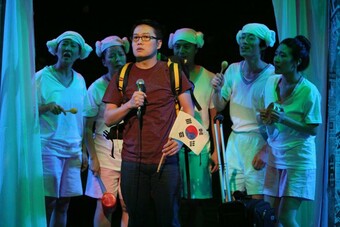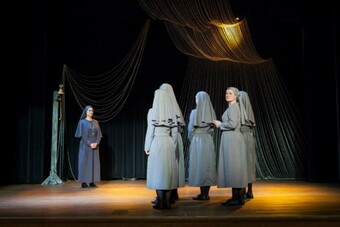Parhelion Stages Small Town Life, and Racial Tensions
According to Abbey Swafford, in the playwright’s notes, which I uncharacteristically read after the production, the seed of Parhelion came from a day ten years ago when Swafford saw what she thought was a sundog after she climbed a hill. Swafford interpreted this luminous phenomenon as the figurative light at the end of the tunnel; a victory over troubled times. Her hopes were dashed upon the realization that the sundog, or parhelion, was actually a false dawn. The full-length drama rendered from this story is filled with metaphors and is as beautiful as it is troubling. Parhelion, a play about false starts and disappointment, marks a very promising beginning for Little Lifeboats in Minneapolis as their inaugural production.
Little Lifeboats as a company has set out to explore new and classic stories with underutilized voices. It was founded by Victoria Pyan, Erin Denman, Joy Dolo, and Swafford out of an event Denman and Pyan organized called TEASE (which stands for: The Easy Access Script Experience). TEASE is an annual event that stages ten-minute teasers of full-length scripts for local artistic directors so that local theater companies can sample Minneapolis-based playwrights in the hopes of producing their work. It was at the first TEASE two years ago where Pyan staged an excerpt of Parhelion.
The play is set in the small fictional Minnesotan town of Bedabun that bears a strong resemblance to Bemidji. The townspeople believe Bedabun means sundog but one of the characters explains that Bedabun is actually Ojibwe for false dawn. The dramatic action follows three childhood friends, now in their late twenties. Ingrid (Cristina Castro) works at a gas station and is unable to finish the last paper needed for her master’s degree, Chantal (Joy Dolo) grew up being the only black girl in school and now teaches art to children, and Hannah (Erin Denman) escaped the trappings of her small town but is currently unemployed. Hannah returns to her hometown so the trio can celebrate Halloween. Mark (Matt Wall) is Hannah’s brother and is Ingrid’s first love and she still holds a candle for him much to Hannah’s horror. Her hesitation is not the casual repulsion of “eww, you think my brother’s attractive,” but caused by a more serious fear, i.e., “my brother is abusive and dangerous.” This new romantic tension is added to existing tensions among the trio. As they argue over what should be their group costume for Halloween this year, it becomes clear that they are actually arguing over how they see themselves as individuals and how they relate to each other.

The group has an almost compulsive need to celebrate Halloween to the hilt and recreate the good times of their childhood. For Ingrid, Hannah, and Chantal, Halloween is the cornerstone holiday that cements their friendship and allows them to embrace their outcast status in their small town. When they were younger they dressed as “realistic” Disney princesses. Ingrid was Ariel after turning into sea foam, Hannah was Sleeping Beauty after getting raped in her slumber, and Chantal, not having a black Disney princess to embody, abandoned the princesses altogether and was Crow Jim from Dumbo. That’s right, Crow Jim from Dumbo. This joke embodies the blunt manner in which the play addresses racism and sexism in America and this is only possible because Swafford has decided to represent the racial diversity of rural Minnesotan women. The script takes its gloves off and comes at you swinging with unflinching honesty dipped in dark humor.
Chantal tells frank stories about what it was like to be the only black girl in an all white school. During a heated argument between the two friends, Hannah says, “I’m sorry I’m white, but racism isn’t my fault.” Chantal wanting to hold Hanna accountable for her actions retorts, “Complacency is.” Parhelion also contains more subtle conversations about race. When Mark runs into Ingrid while she is working at the convenient store he tells her, “You look white,” ignoring that Ingrid is Brazilian/Ojibwe-White Earth/Norwegian, Mark also declares that Chantal isn’t “black black” and Ingrid quickly replies with, “what the hell does that mean” and Mark clarifies “you know gangster, street, urban.”
The play is careful not to condemn any of the women even though they question each other’s actions.
In spite of Mark’s red flag racist remarks, Ingrid decides to romantically pursue him recklessly. The next time Mark visits Ingrid; she is having lunch in a park during her break and he convinces her to ditch work to have sex with him by first asking her how important working at a convenience store is to her and then by giving her a few hundred dollars to cover her rent just in case she loses the job. It makes a certain kind of logic at the time but once Hannah discovers this detail she calls Ingrid a whore and the play is given another level of complexity with this serious conflict between the two friends.
The play is careful not to condemn any of the women even though they question each other’s actions. Mark’s character is less complex than the other three and at times feels like a plot devise to cause tension between the other characters. Wall’s performance however was not one-dimensional. Wall’s performance of Mark was most terrifying not during the bursts of rage leading him to strangle Ingrid repeatedly but during his sweetly delivered apologies and his gentle pleas to Ingrid to take him back.
Swafford’s writing is complex but not convoluted. The play is about many things (racism, domestic violence, friendship, slut shaming, growing apart, class disparity) but the narrative is never muddled because all of the subjects are grounded in small town life. The characters struggle with feeling stuck and the claustrophobia is replicated in the small set in the converted warehouse space. In an effort to be economical, Little Lifeboats re-purposed the set left behind from another production. During tech week, an electrical mishap fried the dimmer box so the transition lights were an abrupt on and off. The technical shortcomings of the production (simple set, simple lights) were a big obstacle to overcome but the well-crafted performances and sharp direction made for some effective storytelling and let the smartness of the writing shine.
The play ends with the three friends united. Mark goes to jail and the friends finally decide what to be for Halloween by abandoning their previously held group costume ideas. Instead they all decide to embody winged victory and they each wear a pair of wings. Ingrid is able to escape what could have been a cycle of violence and as the women huddle around the campfire in their wings and reaffirm their friendships, we the audience see hope with this happy ending; a light at the end of a dark brutal tunnel.






Comments
The article is just the start of the conversation—we want to know what you think about this subject, too! HowlRound is a space for knowledge-sharing, and we welcome spirited, thoughtful, and on-topic dialogue. Find our full comments policy here
Chris, thanks for writing this. I'm sad I missed the show but I appreciate your well-written and thoughtful critique.
I look forward to a play about rural life that isn't about being trapped in a repressive, intolerant situation. There was a time when plays, novels, and short stories portrayed a broader view of rural life, but today, especially in theatre, this rarely seems to be the case.